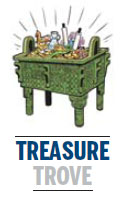Porcelains reveal five ways to color history
Updated: 2012-02-23 13:03
By Cheng Anqi (China Daily)
|
|||||||||||

Editor's Note: Every week we look at a work of art or a cultural relic that puts the spotlight on China's heritage.
 The Qing Dynasty (1644-1911) was an era of ceaseless war. Both official and private kilns were unused until the middle of the rule of Kangxi (1654-1722).
The Qing Dynasty (1644-1911) was an era of ceaseless war. Both official and private kilns were unused until the middle of the rule of Kangxi (1654-1722).
The stabilization of society led to socioeconomic development that's reflected in the flourishing of porcelain during that time.
It was during Kangxi's reign that the decorative wucai (five colors) porcelains grew in prominence.
While most works featured red, green, yellow, brown and purple glazes, gold and black were also extensively applied, adding resplendence and flamboyance.
One specimen of this genre is the Wucai Porcelain Vase with Butterfly Design in the Palace Museum's collection.
The 44-cm-high artwork depicts its subjects in an accomplished, painterly style, using red, yellow, black, blue, brownish red, violet and green.
Its slightly flared mouth rises from a short neck and rounded shoulders. Its body contracts slightly from below the shoulders and falls sharply to the rounded base, which bears no reign mark or other inscription. The area below the shoulders and all the way to the bottom is painted with flying butterflies interspersed with dragonflies.
Butterflies first appeared as decoration on porcelains in the Five Dynasties and Ten Kingdoms (AD 907-960) period. They're symbols of auspiciousness and happiness.
They are usually thought to signify venerable old age, prosperity and nobility - like cats and peonies - and express the desire for boundless wealth and glory.
The painting on this vase is created with exquisite brush strokes, featuring butterflies in groups of threes and fives.
No two butterflies are the same, and their distinctiveness creates a riot of shining colors.
One characteristic of Kangxi five-colored porcelains is a watery light green hue. Every butterfly is painted in exuberant colors. A shimmering yellowish gold is used to embellish the green wings. Blue and white are accentuated with enamels and an elegant powder blue color enhances the blue butterflies, so the multicolored brilliance of the whole picture is brought out in full.
In the Qing period, wares for imperial use were supplied by the official ceramic workshops of Jiangxi province's Jingdezhen, which is known as the country's "ceramic capital".
Most of the official wares were sent for firing in private kilns, where they got the best firing positions in the furnaces to ensure the highest quality products.
This became the established system after the 19th year of Kangxi's reign.
But a study of Kangxi polychromes finds imperial kilns' products are inferior to private kilns.
Most imperial wares were small pieces with uninteresting designs, such as dishes and bowls. But the jars and vases for private use are not only larger but also more splendidly colorful and of livelier designs.
So, connoisseurs judge Kangxi period vessels on their own merits, rather than the kilns that fired them.
Today's Top News
Rescuers race against time for quake victims
Telecom workers restore links
Coal mine blast kills 18 in Jilin
Intl scholarship puts China on the map
More bird flu patients discharged
Gold loses sheen, but still a safe bet
US 'turns blind eye to human rights'
Telecom workers restore links
Hot Topics
Lunar probe , China growth forecasts, Emission rules get tougher, China seen through 'colored lens', International board,
Editor's Picks

|

|

|

|

|

|





